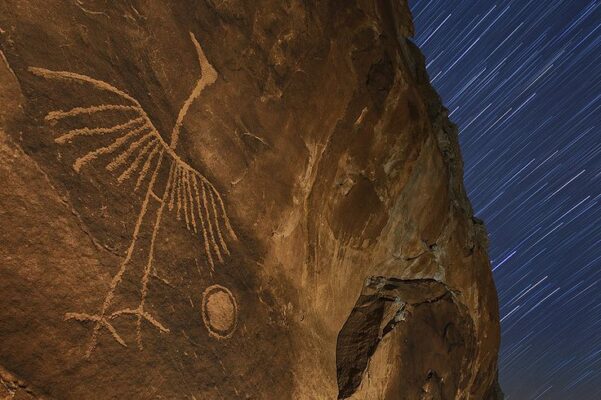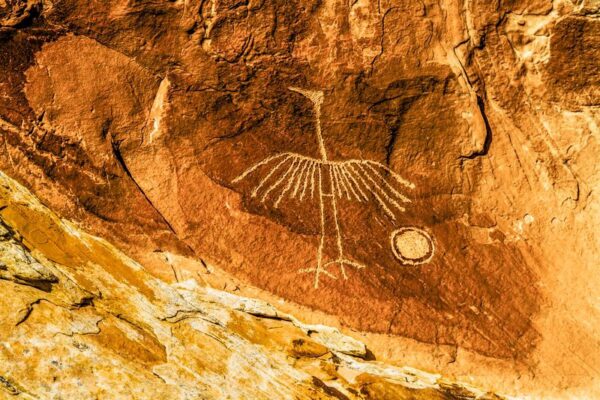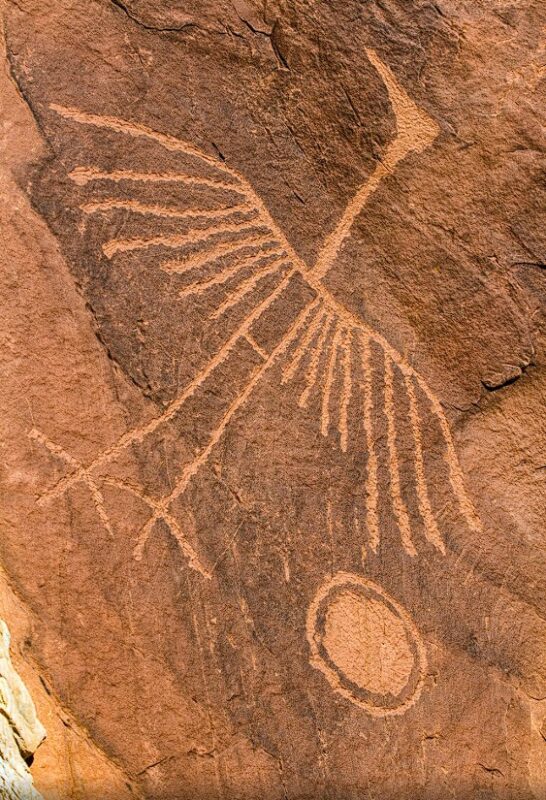Nestled in the breathtaking landscape of Bears Ears National Monument in southeastern Utah, a remarkable rock art pictograph stands as a testament to the ancient cultures that once thrived in the region. This incredible artwork, etched into the rocks, has withstood the test of time, offering us a glimpse into the spiritual and cultural practices of the indigenous peoples who inhabited this land thousands of years ago. Let’s explore ancient civilization with archeology.dulichvn.net.

A Glimpse into Ancient History
The Significance of Rock Art in Utah
Bears Ears National Monument is renowned for its rich archaeological and cultural history, with rock art being one of its most notable features. These ancient pictographs and petroglyphs are more than just decorations; they serve as a window into the lives, beliefs, and traditions of the Native American tribes who once called this area home.
Symbolism and Spiritual Meaning
The rock art at Bears Ears is not merely decorative; each symbol and figure holds deep spiritual significance. For the indigenous cultures, these images likely represent religious practices, rituals, and stories passed down through generations, providing insights into their worldview and connection to nature.
Preserving Cultural Heritage
These ancient rock art sites are invaluable for understanding the history of the region and its first inhabitants. Efforts to preserve these fragile artworks are ongoing, as they are crucial to maintaining the cultural legacy of the native tribes that once used the land.

Timeless Rock Art of Bears Ears : A Sacred and Historic Landscape
A Cultural Landscape
The landscape of Bears Ears National Monument is rich in cultural heritage. The monument is not just a location for rock art, but also includes sacred sites, ancient dwellings, and other archaeological remnants that showcase the deep connection between the indigenous peoples and the land.
Bears Ears and Indigenous Peoples
The monument gets its name from the Bears Ears, two prominent rock formations that have significant spiritual meaning to Native American tribes, including the Navajo, Hopi, Zuni, and Ute peoples. These tribes have long revered the land, and the area is considered a sacred site, with many places of historical importance scattered across its vast expanse.
The Role of Bears Ears in Native American Culture
Bears Ears has been an area of cultural importance for millennia. The rock art found in the monument is a powerful reminder of the ongoing connection between the land and the people, serving as a cultural bridge between past and present generations.

Rock Art: A Testament to Ancient Ingenuity
The Creation of Pictographs
The pictographs in Bears Ears are created using natural pigments, applied to rock surfaces in a way that still captures the imagination of visitors today. These artworks were created using techniques passed down through generations, showcasing the artistic skill and ingenuity of the ancient peoples.
Styles and Techniques
The artwork at Bears Ears includes a variety of styles, ranging from simple geometric shapes to more intricate depictions of animals and human figures. The diverse techniques used demonstrate the rich artistic traditions that were integral to the cultures of the Southwest.
Rock Art as a Storytelling Medium
The pictographs are thought to have been used as a way of telling stories, recording historical events, and communicating with future generations. They provide insight into the lives of those who lived in the region long before European settlers arrived, offering a glimpse into a way of life that has long been forgotten by history.

The Enduring Legacy of Bears Ears National Monument
Rock Art in the Modern Era
Despite centuries of exposure to the elements, the rock art at Bears Ears continues to capture the attention of archaeologists, historians, and visitors alike. The enduring legacy of these pictographs highlights the resilience of ancient cultures and their ability to leave lasting marks on the landscape.
Threats to Preservation
While the rock art at Bears Ears has stood the test of time, it is still vulnerable to environmental threats such as erosion, weathering, and human activity. Continued preservation efforts are crucial to ensuring that these historical treasures remain intact for future generations to appreciate.
Educational Value and Cultural Connection
Today, Bears Ears National Monument is not only a site of historical and archaeological significance but also a place of cultural connection for Native American tribes. Visitors to the monument are encouraged to respect the sacredness of the land and learn about its history through educational programs and guided tours, helping to preserve its importance for future generations.
See more: The 2,000-Year-Old Roman Handprint in Cherchell
Conclusion: A Window Into the Past
The rock art pictographs of Bears Ears National Monument in Utah are more than just ancient artworks—they are a powerful reminder of the deep and enduring cultural heritage of the indigenous peoples who once inhabited the region. These striking images provide a rare and fascinating glimpse into a past that continues to influence the present, preserving a timeless connection between the land, its people, and their stories.


CÁC TIN KHÁC
Mark Twain & Olivia Langdon: A 36-Year Love Story Filled with Laughter and Devotion
The Tollund Man: A 2,400-Year-Old Mystery Preserved in a Danish Bog
Skara Brae: Scotland’s Hidden Neolithic Village
Porta Nigra: The Hidden Depths of Trier’s Iconic Roman Gate